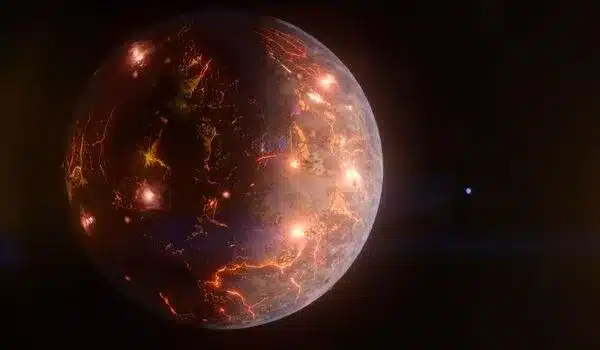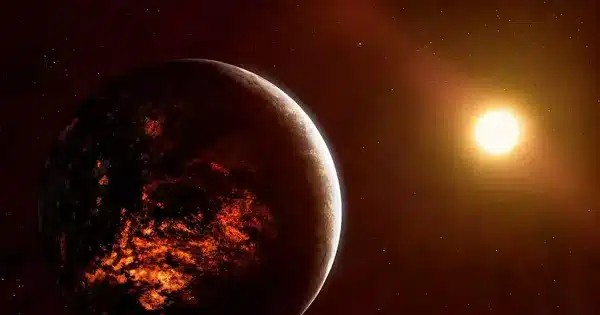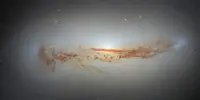In a new study, scientists discovered that sweeping molten oceans have a substantial influence on the observable attributes of hot rocky Super-Earths, such as their size and evolutionary route. Lava worlds, enormous exoplanets with glittering skies and boiling volcanic seas known as magma oceans, are diametrically opposed to the planets in our solar system.
To date, approximately half of all rocky exoplanets known are capable of retaining magma on their surfaces, most likely because these planets are so close to their home stars that they revolve in less than 10 days. Being so close leads the planet to be pounded by violent weather and forces surface temperatures to extremes, making it all but uninhabitable to life as we know it today.
According to a new study, these sweeping molten oceans have a significant influence on the observable attributes of hot rocky Super-Earths, such as their size and evolutionary route.
Their findings, published recently in The Astrophysical Journal, show that oceans of magma can cause lava-rich planets without atmospheres to be slightly denser than similarly sized solid planets, as well as influence the structure of their mantles, the thick inner layer that surrounds a planet’s core.
Lava worlds are very odd, very interesting things, and because of the way we detect exoplanets, we’re more biased to finding them. When planets initially form, particularly rocky terrestrial planets, they go through a magma ocean stage as they’re cooling down.
Kiersten Boley
Even so, because these objects are famously understudied, characterizing the fundamental workings of lava planets can be tough, according to Kiersten Boley, the main author of the study and a Ph.D. student in astronomy at The Ohio State University.
“Lava-worlds are very odd, very interesting things, and because of the way we detect exoplanets, we’re more biased to finding them,” said Boley, whose research focuses on determining what essential ingredients distinguish exoplanets and how changing those elements, or in the case of lava worlds, their temperatures, can completely alter them.
55 Cancri e, an exoplanet around 41 light-years away that scientists describe as having both glittering skies and seething lava seas, is one of the most well-known of these intriguing burning worlds.
While there are several objects in our solar system that are extremely volcanically active, such as Jupiter’s moon Io, there aren’t any actual lava planets that scientists can investigate up close and personal. However, examining how the composition of magma oceans contributes to the evolution of other planets, such as how long they remain molten and why they eventually cool down, can provide clues into Earth’s own fiery history, according to Boley.

“When planets initially form, particularly for rocky terrestrial planets, they go through a magma ocean stage as they’re cooling down,” Boley explained. “So lava worlds can give us some insight into what may have happened in the evolution of nearly any terrestrial planet.”
Researchers simulated several evolutionary scenarios of an Earth-like planet with surface temperatures ranging from 2600 to 3860 degrees Fahrenheit – the melting point at which the planet’s solid mantle would turn to liquid – using the exoplanet interior modeler software Exoplex and data collected from previous studies to construct a module that included information on several types of magma compositions.
From the models they created, the team was able to discern that mantles of magma ocean planets can take on one of three forms: the first in which the entire mantle is completely molten, the second where a magma ocean lies on the surface, and a third sandwich-esque model that consists of a magma ocean at the surface, a solid rock layer in the middle and another layer of molten magma that lies closest to the planet’s core.
The data indicate that the second and third kinds are slightly more common than fully molten worlds. Some atmosphere-free exoplanets are better than others at storing volatile elements – chemicals such as oxygen and carbon required for the creation of early atmospheres – for billions of years, depending on the nature of magma oceans.
The study, for example, indicates that a basal magma class planet four times the mass of Earth may hold more than 130 times the mass of water currently existing in Earth’s seas, as well as roughly 1,000 times the amount of carbon currently present in the planet’s surface and crust.
“When we’re talking about the evolution of a planet and its potential to have different elements that you would need to support life, being able to trap a lot of volatile elements within their mantles could have greater implications for habitability,” said Boley.
Lava planets are a long way from becoming livable enough to support life, but understanding the processes that help these worlds get there is critical. Nonetheless, when compared to solid exoplanets, this study shows that assessing their density isn’t the greatest way to classify these worlds because a magma ocean neither considerably enhances nor decreases its planet’s density, according to Boley.
Instead, their findings suggest that scientists should concentrate on other terrestrial factors, such as oscillations in a planet’s surface gravity, to test their beliefs about how hot lava planets work, especially if future researchers intend to use their data to aid in bigger planetary studies.
“This work, which is a combination of earth sciences and astronomy, basically opens up exciting new questions about lava worlds,” said Boley.















